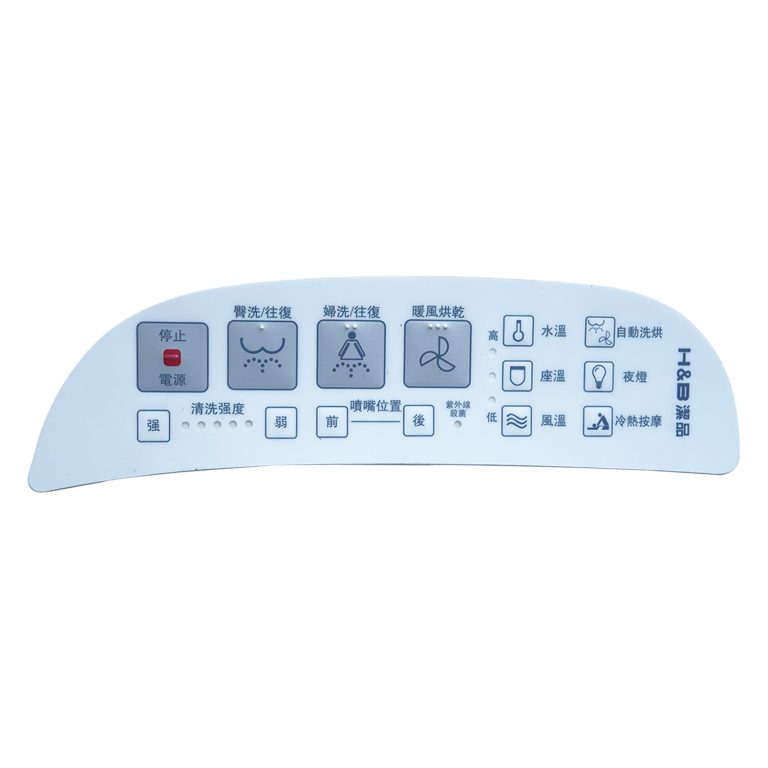What is A “Graphic Overlay”?
Graphic overlays are thin, flexible layers typically made from materials such as polyester, polycarbonate, or acrylic. They feature printed graphics, symbols, or text that are visible through transparent windows or cutouts. Graphic overlays are commonly used in electronic devices, control panels, and industrial equipment to provide clear labeling, instructions, and visual indicators for user interfaces. They enhance the aesthetic appeal and functionality of products by displaying key information, control functions, and branding elements. Faceplate graphic overlays are customizable and can be tailored to specific requirements, including design, size, shape, and material properties. They offer durability, resistance to wear and tear, and ease of installation, making them essential components in various applications across industries such as electronics, automotive, medical, aerospace, and industrial manufacturing.
Features & Benefits of Graphic Overlay Include:
Graphic overlay refers to the process of adding or overlaying graphical elements onto an existing image, background, or interface. Here are the key features and benefits of graphic overlay:
- Flexibility:
Graphic overlay offers a high level of flexibility, allowing users to add, modify, or remove overlay elements as needed.
- Diversity:
A wide range of graphical elements can be used for overlays, including images, text, symbols, shapes, and more. This diversity enables users to create overlays that meet specific design or functional requirements.
- Customizability:
Control graphic overlay elements can be customized in terms of their appearance, size, position, and other properties. This allows for precise control over the look and feel of the overlay.
- Scalability:
Graphic overlays can be scaled to fit different screen sizes and resolutions, ensuring consistent visual quality across devices.
- Interactivity:
When used in interactive applications, graphic overlays can be designed to respond to user input, such as clicks or taps, adding another level of functionality.
Graphic overlay benefits include improved visual appeal, better information presentation, branding and identity, dynamic content, and improved accessibility.
How Are Graphic Overlay Constructed?
Based on the general principles of graphic design and overlay, control panel overlay can contain multiple layers, but the specific number of layers depends on the design requirements, application scenarios and technical implementation.
- Base layer: Usually the lowest layer, used to provide a background or base pattern.
- Middle layer:
There can be multiple layers for adding different graphics, text, images, or other design elements. These layers can be stacked, adjusted for position, transparency, etc., as needed.
- Top layer:
Located at the very top, it may be used to add finishing touches, effects, or interactive elements.
It should be noted that different front graphics overlay products may have different layers and design structures. Some simple graphics overlays may contain only a few layers, while complex graphics overlays may contain dozens or more layers.

BX Panel Graphic Overlay Technical Information
High precision graphic design:
Graphic overlay typically requires a high degree of graphic design precision to ensure clarity and accuracy of the final product.
This includes the use of high-resolution images, accurate dimensional measurements, and detailed graphic design elements.
Diverse selection of materials:
Graphic overlay panel fabrication materials can be selected according to application requirements to achieve specific performance characteristics.
Common materials include Mylar, polycarbonate, PVC, etc., which have different hardness, transparency, weather resistance, and chemical stability.
Precise printing technology:
Printing is one of the key steps in making graphic overlay, which directly affects the visual effect of the final product.
Precise cutting and forming:
The precise cutting and molding of graphic overlay label is a key step in ensuring that the final product meets the design requirements.
What Special Features Can Be Incorporated into Graphic Overlay?
Graphic overlay supports high-resolution graphics support to ensure clarity and detail of the image, so that it can show more complex patterns or fine text.
Different materials can be selected according to different application environments to make graphic overlay nameplate. For example, materials with strong weather resistance are suitable for outdoor environment, while soft materials are more suitable for bending or irregular scenes.
For some special environments (chemical plants or laboratories), graphic overlay needs to be resistant to chemical corrosion. The selection of special materials or surface treatment technology can enhance the chemical stability of Graphic overlay and extend its service life.
Graphic overlay can integrate touch screen functionality, making it an interactive interface. Through the touch screen, users can directly perform operations on it, such as tapping, sliding or gesture recognition.
Graphic faceplate can be linked in serial port, USB, and Ethernet modes. You can select an appropriate connection mode based on your requirements.

Design Features of Graphic Overlay
Graphic overlay has dynamic and static rendering modes, which are suitable for situations where a large number of graphics are included in a layer to avoid slow graphics update affecting the experience. It is very flexible and easy to integrate into a variety of applications, such as displaying simple geometric graphics, text, walking routes, GPS positioning, etc. Graphic control nameplate also provides a precise color matching system that ensures visual harmony. Graphic overlay has good electrical properties, such as high resistance and low cost, and is suitable for various electrical and electronic equipment.
What Industries Use Graphic Overlay?
Widely used in electronic communication, electronic measurement instruments, industrial control, medical equipment, automobile industry, intelligent toys, household appliances and other fields.